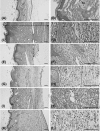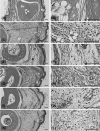Effect of DHU001, a Polyherbal Formula on Formalin-induced Paw Chronic Inflammation of Mice
- PMID: 24278557
- PMCID: PMC3834374
- DOI: 10.5487/TR.2011.27.2.095
Effect of DHU001, a Polyherbal Formula on Formalin-induced Paw Chronic Inflammation of Mice
Abstract
The effect of DHU001, a mixed herbal formula consisted of 7 types aqueous extracts for various respiratory disorders were evaluated on the formalin-induced paw chronic inflammation in mice after oral administration. Mice were subaponeurotically injected in the left hind paw with 0.02 ml of 3.75% formalin, then subjected to 500, 250 and 125 mg/kg of DHU001 oral administration, once a day for 10 days during which then the hind-paw thickness and volume were measured daily. The paw wet-weight, histological profiles, histomorphometrical analyses and paw tumor necrosis factor (TNF)-α contents were conducted at termination. After two formalin treatments, a marked increase in the paw thickness and volume was detected in the formalin-injected control as compared with that in the intact control, plus at the time of sacrifice the paw wet-weights, paw TNF-α contents were also dramatically increased with severe chronic inflammation signs at histopathological observations. However, these formalin-induced chronic inflammatory changes were dramatically decreased by treatment of dexamethasone and all three different dosages of DHU001. DHU001 has favorable effects on formalin-induced chronic inflammation mediated by TNF-α suppression, and DHU001 may represent an alternative approach for the treatment of chronic inflammatory diseases.
Keywords: Chronic Inflammation; DHU001; Mouse; Polyherbal Formula; Tumor Necrosis Factor.
Figures



Similar articles
-
Effect of DHU001, a Polyherbal Formula, on Dinitrofluorobenzene-induced Contact Dermatitis (Type I allergy).Toxicol Res. 2010 Jun;26(2):123-30. doi: 10.5487/TR.2010.26.2.123. Toxicol Res. 2010. PMID: 24278515 Free PMC article.
-
Effects of DHU001, a Mixed Herbal Formula on Acute Inflammation in Mice.Toxicol Res. 2008 Sep;24(3):189-194. doi: 10.5487/TR.2008.24.3.189. Epub 2008 Sep 1. Toxicol Res. 2008. PMID: 32038794 Free PMC article.
-
Mouse Single Oral Dose Toxicity Study of DHU001, a Polyherbal Formula.Toxicol Res. 2010 Mar;26(1):53-9. doi: 10.5487/TR.2010.26.1.053. Toxicol Res. 2010. PMID: 24278506 Free PMC article.
-
Micronucleus Test of DHU001, a Polyherbal Formula, in Bone Marrow Cells of Male ICR Mice.Toxicol Res. 2009 Dec;25(4):225-230. doi: 10.5487/TR.2009.25.4.225. Epub 2009 Dec 30. Toxicol Res. 2009. PMID: 32038842 Free PMC article.
-
The effects of local pentoxifylline and propentofylline treatment on formalin-induced pain and tumor necrosis factor-alpha messenger RNA levels in the inflamed tissue of the rat paw.Anesth Analg. 2004 Jun;98(6):1566-1573. doi: 10.1213/01.ANE.0000113235.88534.48. Anesth Analg. 2004. PMID: 15155307
Cited by
-
Extracellular polysaccharides purified from Aureobasidium pullulans SM‑2001 (Polycan) inhibit dexamethasone‑induced muscle atrophy in mice.Int J Mol Med. 2018 Mar;41(3):1245-1264. doi: 10.3892/ijmm.2017.3251. Epub 2017 Nov 10. Int J Mol Med. 2018. PMID: 29138805 Free PMC article.
-
Acyclic Triterpenoid Isolated from Alpinia katsumadai Alleviates Formalin-Induced Chronic Mouse Paw Inflammation by Inhibiting the Phosphorylation of ERK and NF-κB.Molecules. 2020 Jul 23;25(15):3345. doi: 10.3390/molecules25153345. Molecules. 2020. PMID: 32717961 Free PMC article.
-
Anti-allodynic effect of interleukin 10 in a mouse model of complex regional pain syndrome through reduction of NK1 receptor expression of microglia in the spinal cord.J Pain Res. 2018 Sep 4;11:1729-1741. doi: 10.2147/JPR.S166624. eCollection 2018. J Pain Res. 2018. PMID: 30233230 Free PMC article.
-
The administration of Fructus Schisandrae attenuates dexamethasone-induced muscle atrophy in mice.Int J Mol Med. 2015 Jul;36(1):29-42. doi: 10.3892/ijmm.2015.2200. Epub 2015 May 4. Int J Mol Med. 2015. PMID: 25955031 Free PMC article.
References
-
- Aimbire F., Penna S.C., Rodrigues M., Rodrigues K.C., Lopes-Martins R.A., Sertié J.A. Effect of hydroalcoholic extract of Zingiber officinalis rhizomes on LPS-induced rat airway hyperreactivity and lung inflammation. Prostaglandins Leukot. Essent. Fatty Acids. (2007);77:129–138. doi: 10.1016/j.plefa.2007.08.008. - DOI - PubMed
LinkOut - more resources
Full Text Sources

